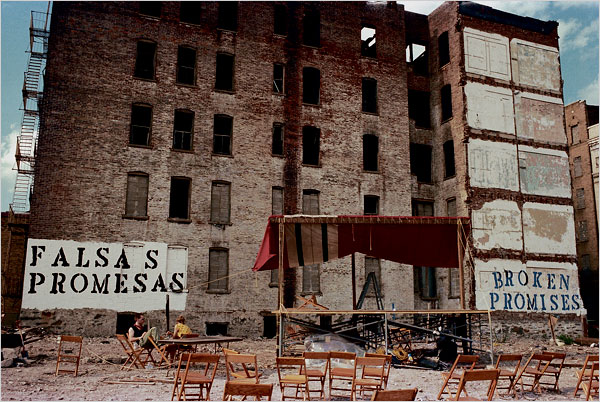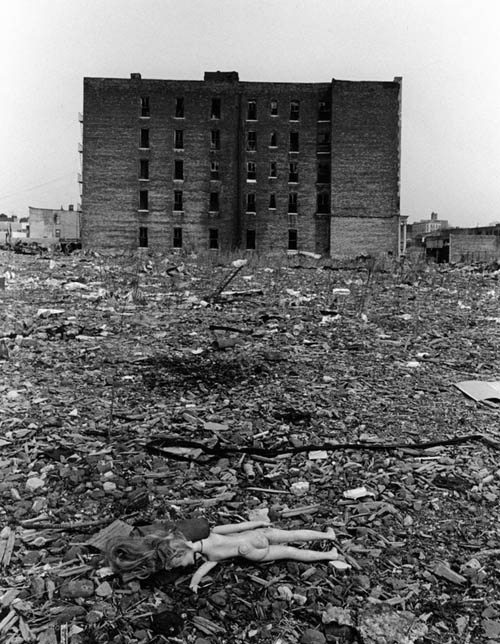The Fires
I want to remind anyone near New York tonight that author Joe Flood will be presenting his book The Fires: How a Computer Formula, Big Ideas, and the Best of Intentions Burned Down New York City—and Determined the Future of Cities.
 [Image: Photo by Lisa Kahane, courtesy of the New York Times].
[Image: Photo by Lisa Kahane, courtesy of the New York Times].
As I mentioned here the other week, The Fires covers a huge range of topics, from NYC neighborhoods where a full 90% of the buildings burned down to a short history of the RAND Corporation, from the analytic shortcomings of statistical urban planning to the larger-than-life people who implemented these increasingly catastrophic financial decisions that inadvertently set the city ablaze.
The book also has some memorable details about the fire department's interaction with the built environment, including highly codified response protocols for different architectural forms, fire chiefs "studying structural defects in new skyscraper designs" and "pressure differentials in the city's water mains," even while driving around the city with "blueprints of local buildings in their cars," and survival tips for firefighters lost in the smoke of a burning building.
We learn, for instance, that fire crews developed a whole repertoire of unconventional forensic techniques for reorienting themselves in a burning building. Flood quotes a fireman: "Maybe you'd have to tear up the linoleum on the floor to find the old wood beneath it and see which way the seams ran to find the door out. All those little tricks to stay alive, it was really something else, excitement-wise."
These adrenalin-fueled nights of often multi-block blazes are very poignantly juxtaposed with tales of wrecked families, whole neighborhoods erased from the map, and a borough—the South Bronx—deliberately abandoned once the damage got bad enough by city planners pursuing a policy of "planned shrinkage."
 [Image: Photo by Mel Rosenthal, courtesy of the Duke University Libraries].
[Image: Photo by Mel Rosenthal, courtesy of the Duke University Libraries].
Flood will launch his book tonight, following an introduction by Steven Johnson, author of The Ghost Map, Everything Bad is Good for You, and many more; I will also be there, interviewing Flood about The Fires and then fielding audience questions with Johnson's moderation.
The whole thing will be followed by drinks, a DJ, and a book-signing.
Things kick off at 7pm over at powerHouse Books in Brooklyn; here is a map. Hope to see you there!
 [Image: Photo by Lisa Kahane, courtesy of the New York Times].
[Image: Photo by Lisa Kahane, courtesy of the New York Times].As I mentioned here the other week, The Fires covers a huge range of topics, from NYC neighborhoods where a full 90% of the buildings burned down to a short history of the RAND Corporation, from the analytic shortcomings of statistical urban planning to the larger-than-life people who implemented these increasingly catastrophic financial decisions that inadvertently set the city ablaze.
The book also has some memorable details about the fire department's interaction with the built environment, including highly codified response protocols for different architectural forms, fire chiefs "studying structural defects in new skyscraper designs" and "pressure differentials in the city's water mains," even while driving around the city with "blueprints of local buildings in their cars," and survival tips for firefighters lost in the smoke of a burning building.
We learn, for instance, that fire crews developed a whole repertoire of unconventional forensic techniques for reorienting themselves in a burning building. Flood quotes a fireman: "Maybe you'd have to tear up the linoleum on the floor to find the old wood beneath it and see which way the seams ran to find the door out. All those little tricks to stay alive, it was really something else, excitement-wise."
These adrenalin-fueled nights of often multi-block blazes are very poignantly juxtaposed with tales of wrecked families, whole neighborhoods erased from the map, and a borough—the South Bronx—deliberately abandoned once the damage got bad enough by city planners pursuing a policy of "planned shrinkage."
 [Image: Photo by Mel Rosenthal, courtesy of the Duke University Libraries].
[Image: Photo by Mel Rosenthal, courtesy of the Duke University Libraries].Flood will launch his book tonight, following an introduction by Steven Johnson, author of The Ghost Map, Everything Bad is Good for You, and many more; I will also be there, interviewing Flood about The Fires and then fielding audience questions with Johnson's moderation.
The whole thing will be followed by drinks, a DJ, and a book-signing.
Things kick off at 7pm over at powerHouse Books in Brooklyn; here is a map. Hope to see you there!





Comments are moderated.
If it's not spam, it will appear here shortly!
This sounds like an interesting look into the workings of a department under stress and may provide a new perspective on specific mechanics that allowed the fires cause more damage than they might have.
However, to present this as an alternative explanation for the fires, and to attempt to displace the existing narrative of extensive economic warfare on the urban poor, which culminated in many property-owning members of the community committing arson and insurance fraud as their means of escape, seems both needlessly focused on simple mechanical explanations over complex social ones, and potentially regressive in its political message.
Walt, I assume that you're reviewing my blog post and not the book, which it sounds like you haven't read?
I am only objecting to the tone taken by the post and the book cover and in the reviews on amazon, which all present the work as a new narrative of what caused the fires, moving the existing narrative either explicitly or implicitly to the background.
I appreciate the attention to the subject and am interested in the insights within the book, which I haven't yet read.
Walt, I look forward to your thoughts on the book and its historical research, if you do pick up a copy.
Just as a matter of record, the bilingual graffiti visible in the first image is a work by nyc artist john fekner.
http://en.wikipedia.org/wiki/John_Fekner
Post a Comment